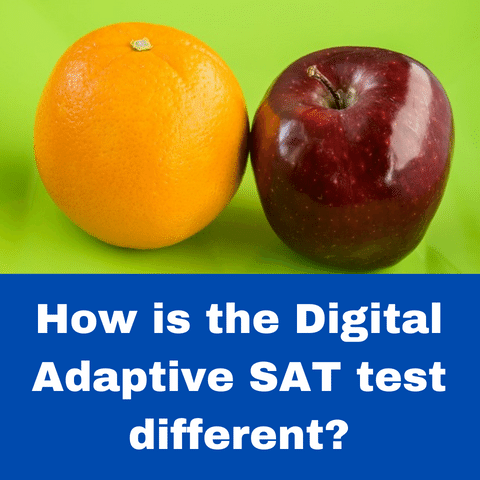Digital SAT Differences
It’s shorter! So much shorter! The paper SAT is 3 ¼ hours from start to finish (NOT counting all the getting ready to test time while you bubble in your name and stuff at the beginning!) while the new Digital Adaptive SAT is just over 2 ¼ hours from start to finish (with NO tedious bubbling in your name before your start). That’s over 30% fewer minutes sitting and testing!
There are fewer questions. The Verbal section has 45% fewer questions; while the Math section has 25% fewer questions. At the same time, students have 15% more time to answer each question.
The scoring is section adaptive. The first verbal and first math modules have a mix of easy, medium, and hard questions. Then, the second verbal and second math modules adapt to the student’s performance on the first module and give more easy or more hard questions. Also, some questions are worth more than other questions when calculating the final score. Finally, each module contains two “pre-test” questions that don’t count toward the students score but are being tested for future tests. From the student’s perspective, all of this will be invisible. Students should simply work to get as many right on each section as possible. Students will be able to work on the questions in any order in a given module.
Each student’s test will be different from another’s. Each test will be comprised of a selection of questions from a large bank of questions, ensuring that students will be unlikely to find help on their neighbor’s screen.
The Digital Adaptive SAT has a lot of great tools to make the testing experience easier and less stressful.
- The timer will be visible on the screen during the whole test. No more wondering how much time is left! The timer can also be hidden until the last five minutes if a student would prefer.
- Students can use the built-in Desmos calculator on all math questions. Desmos is a game changer!! Students can still bring their own calculator as well.
- A built-in formula reference sheet is available.
- Students have an array of tools on-screen to help focus: Flag and review individual questions, annotate on screen, highlight text, cross-out wrong answers, zoom to make text bigger, change how much of the screen is devoted to the text or question.
The Verbal section has no more long passages! That’s right, you no longer have to read 800 words about the life cycle of the glow worm. Instead, each verbal question has a paragraph of 25 – 150 words. There are now a larger variety of genres represented (hello poetry!) but no more “Great Global Conversation” passages (goodbye Politics passages!). Being familiar with college level vocabulary takes on greater importance in the Digital Adaptive SAT.
The Math section is relatively similar to the current paper SAT in terms of topics covered and question formats. The biggest change is that there are significantly fewer words per problem, as well as a big reduction in the number of word problems. 70% of questions will be “pure” math questions. Fewer “walls of text” with which to contend! There will be more problems covering geometry (now up to 15%) and fewer data analysis questions (down to 15% of the total math questions) with fewer words per question.
Also, the built-in Desmos calculator will be a game changer for students who choose to learn how to use it. Many, if not most, of the questions can be solved using the Desmos calculator.

